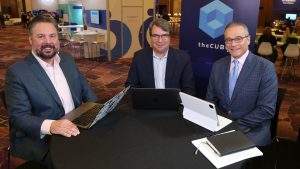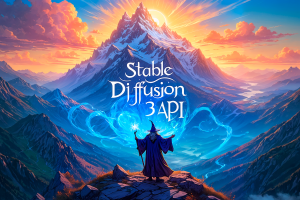How close Is Big Data to its inflection point? | #EMCWorld
![]() At the EMC World conference, Stu Miniman got to speak with two EMC decision makers to shed a little light on Big Data’s burgeoning role in the IT industry. John Cardente, Big Data and Analytics, Corporate CTO Office of EMC and Aiden O’Brien, GM of EMC’s Big Data solutions, walked Miniman through some of their goals for EMC’s Big Data portfolio and their role in the new EMC-VMware-Pivotal (EVP) Federation.
At the EMC World conference, Stu Miniman got to speak with two EMC decision makers to shed a little light on Big Data’s burgeoning role in the IT industry. John Cardente, Big Data and Analytics, Corporate CTO Office of EMC and Aiden O’Brien, GM of EMC’s Big Data solutions, walked Miniman through some of their goals for EMC’s Big Data portfolio and their role in the new EMC-VMware-Pivotal (EVP) Federation.
In his first question, Miniman asked for specific Big Data solutions coming from EMC, to which O’Brien responded that their goal is to help customers with the “whole challenge rather than just one part of it.” This, he indicated, is part of the Federation message.
Reflecting on Cardente’s forward-looking role at the CTO office, Miniman asked him to share some insight into Big Data solutions. Explained his belief that a truly comprehensive Big Data solution needs to offer three components: data, analytics, and applications. This, he said, is what EMC is pursuing in the Federation Solution; the ability to provide customers with the ability to pick and choose what they use to build a datalink for their own Big Data solution.
- Datalink as Comprehensive Platform
Touching on Cardente’s use of the term “datalink,” Miniman asked him to “give us the one-on-one definition of what datalink means?” A datalink, Cardente explained, is a platform that allows users ” to “store everything,” “analyze it, and service the insight.” He compared datalink to a SAND, describing it as a tool that businesses put together to serve their specific needs.
Miniman pressed his interviewees on the nature of the datalink, describing his association with the term datalink and infrastructure, but feeling conflicted because Big Data is more commonly associated with software and services. O’Brian replied that the EMC’s Big Data solution is designed to address a business challenge. So the “plumbing underneath” is all targeted to help the customer leap their business’ particular hurdle.
How EMC Big Data Fits with Current Architecture
.
Miniman wondered whether Big Data will fit with current architecture, or whether it will require a bespoke architecture.
Cardente explained that EMC intends to bridge the gap between traditional and forward-looking environments using Isilon OneFS and ViPR. Unpacking his statement, Cardente added that this new tool will accommodate exiting workflows and applications, but also make “data applicable and available to analytics without having to move it.”
O’Brien built off Cardente’s point, detailing that the Federation is interested in three types of clients: IT, service providers, and born-digital companies. He touched back on Cardente’s earlier comparison to SAND, highlighting that the datalink can be combined to address the needs of the different challenges that each of these types of businesses face.
When asked where each of these different customer sets is with adoption, O’Brien replied that the service providers are catching on fastest: “The want to play in the big leagues.” But, he added, “with enterprises, it varies drastically: some are very advanced, others still need you to explain what these things are.”
Miniman asked for clarity around what exactly the end deliverable is. O’Brien explained the product as “a mix of hard-wired software and services.” The decision to create a product in this way is because the market is still “nascent” for many of their customers: “If we don’t tell them how to do the sequence of projects they need to get this stuff up and running […] we’re not really helping them,” said O’Brien. Their thinking is more for a “holistic, whole-product solution.”
How Execs Embrace and Utilize Big Data
.
CXOs are beginning to glean that Big Data may be useful to their enterprises, O’Brien explained, responding to Miniman’s question about how far along business are when it comes to “understanding how Big Data fits into their purview.”
O’Brien described the different levels of interest: some companies are exploring, some have already have their “first few proof-of-concepts up and running,” and then there are still other companies that are already considering how they can design new products and re-define their business.
Miniman asked his interviewees for an example of a business that had re-defined their business in the way O’Brien had just described. Citing Uber, O’Brien laid out how businesses can make an impact by changing how their customer interacts with a product:
“Uber has a mind share with you as a customer which traditional firms never ever had.” They made ordering a cab cool.
Cardente gave another example from the telecommunications industry, describing a group that discovered “cell data records are not only useful for billing, but also for traffic congestion. So really, they’re finding new ways to extract value from existing data. ” Big data, he elaborated, gave these companies the power to “uncover new relationships to add value.”
- Using Big Data to Identify a Businesses’ Killer App
Next, Miniman asked Cardente and O’Brien to comment on where the Big Data industry is when it comes to software and services and repeatability of the processes, mentioning that big data still doesn’t have a “killer app” associated with its services. O’Brien responded that, because so many companies aim to accomplish different goals with Big Data — “reducing costs, answering existing decisions more quickly, making new types of decisions,” or offering new products and services — a reference sell is a tough one to make.
The tactic O’Brien proposed, though tapped the “services” party of Miniman’s question. His goal is for EMC to participate “in the process of helping a client understand what might be a killer app for them, that’s repeatable.” It will be for the company to decide, with EMC’s expert advice, what the “killer app” will be for their business.
- We No Longer Store Data, We Unlock It
Miniman then asked how EMC balances the division between traditional infrastructure administrators and the “developer camp” typically associated with Big Data. Cardente explained that EMC is more than storage, and therefore will function a little differently. Indeed, Cardente explained that the product is moving towards becoming “much more of a higher level interaction with the storage components than what you see today.”
![]() Miniman suggested, in response to Cardente’s statement, that “storage” is a term that may not apply in this situation: “We want to get at that information and unlock data.” Cardente agreed, mentioning that at EMC they discuss data management, information management, information services to get away from that storage-centered part of the conversion.”
Miniman suggested, in response to Cardente’s statement, that “storage” is a term that may not apply in this situation: “We want to get at that information and unlock data.” Cardente agreed, mentioning that at EMC they discuss data management, information management, information services to get away from that storage-centered part of the conversion.”
Continuing down the storage path, Miniman asked about the how his interviewees saw the decision of storing ” all that information versus having short-term information” fitting into big data discussions.The different EMC tiers, DSSD, Isilon, and ViPR, Cardente said, are designed to “put the right data in the right place.” He sees EMC on a path to help their customers use all three platforms effectively, but that the industry is still figuring out how get all the plates to spin at once.
Balance of Power in EVP
.
Miniman segued into the new Federation makeup, which consists of EMC, VMware, and Pivotal. Where, he asked, is the balance of power? Cardente replied that the entire stack is important — they work together to “add unique, differentiable value individually and then, as a Federation, we can provide the full complement of capabilities that customers need.
O’Brien underscored Cardente’s point, mentioning that the answer to “who has more influence” changes depending on who one is talking to. Some businesses will be most excited about Pivotal because it’s the “newest member of the family” while for others, the “EMC-VMware story is just as important and interesting.”
- How Close Is Big Data to Its Inflection Point?
Describing the way Wikibon looks at adoption, Miniman explained that there’s often an inflection point when a technology really takes off. He asked how close Big Data is to that inflection point. O’Brien said, “Today already, we’re not far from that inflection point.” He indicated though, that until the industry sees “more high-profile cases,” some business won’t tune in to “the fact that this needs to be accelerated.”
A message from John Furrier, co-founder of SiliconANGLE:
Your vote of support is important to us and it helps us keep the content FREE.
One click below supports our mission to provide free, deep, and relevant content.
Join our community on YouTube
Join the community that includes more than 15,000 #CubeAlumni experts, including Amazon.com CEO Andy Jassy, Dell Technologies founder and CEO Michael Dell, Intel CEO Pat Gelsinger, and many more luminaries and experts.
THANK YOU













